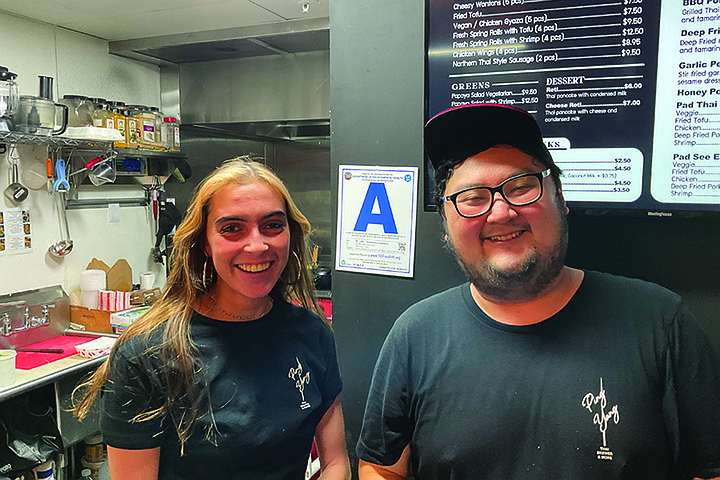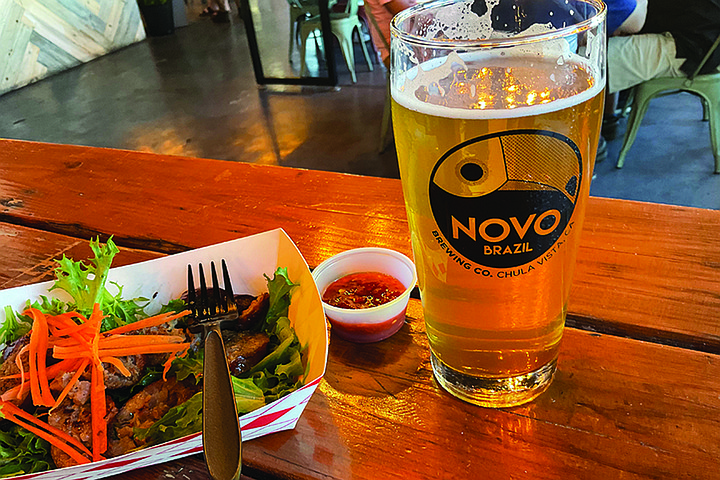 Facebook
Facebook
 X
X
 Instagram
Instagram
 TikTok
TikTok
 Youtube
Youtube

There’s Thai and there’s Thai. You have Thai down south near Malaysia, where we’re talking fish, thick curries, coconuts. Up north, far from the sea, near the mountains of Laos and China, we’ve got freshwater river fish, or rice and meat dishes, and hey, sticky rice. Specially Mamuang Khao Nio, (mango and sticky rice and coconut milk, which comes over you sweet, like an unexpected affair). For me, the essence of what I love about Thai food is the array of aromas your nostrils pick up: like the sour steam rising from a super-spicy and sour Tom Yum Kung (hot soup and veggie mix-up with shrimp). Or the coconutty creaminess of Tom Kah. Ahhhh.
Honestly, though, I’m not expecting too much from this Thai stall inside the Street Market Collective down here in National City. It’s near an Indonesian place, a Filipino eatery, a Mexican stall, a Cajun BBQ place, and a Japanese outfit called Donburi Rice Bowls. But I spotted someone coming away from the corner stall named Ping Yang Thai Skewer & More. The hungry soul carried a cardboard box filled with sausage slices, spiky carrots, and greens. Looked vivid.
Hmm. Maybe I should eat here. I really dig the whole place’s easy atmosphere, with folks sitting at these long, communal tables, and at high-stool counters that look out across 8th Avenue. So I come up to the counter. Gent named Gain, with a laughing Buddha face, stands next to this gal named Bebhinn.

Wow. Bebhinn? A day for exotic names. “Name means ‘Melodious Woman,’” she says. “Irish. My dad loved everything Irish.” And yet, here she is in a little Thai take-out, selling food that’s a world away from the usual Irish meat ’n potatoes fare. Nearest thing might be fried tofu ($7.50), or other generics like fresh spring rolls with shrimp ($12.50) — things that you’d surely find in Dublin.
But then my eye lands on something I’ve been interested in for, like, ever: how very different the various sausages are from each other in this region. Northern Thai vs. southern Thai sausage. Laotian sausage too. But there is this one sausage they say hits the breakfast and lunch bowls everywhere from Chiang Mai to China: Northern Thai sausage! And it’s right here: “Starters: Northern Thai style sausage (two pieces), $9.50.” Normally, I’m tempted by a Tom Yum soup, say, or a nice thick Massaman curry from down near Thailand’s Malaysian border. Not today. Today’s sausage day.
“Uh, any idea what you want yet?” This is Bebhinn, breaking into my reverie.
I do a quick glance through, and am mostly seeing things like “five cheesy wontons” for $8.50, papaya salad with shrimp for $12.50 (without shrimp, $9.50); crab Rangoon, $9.99; or larb (Laotian ground beef and roasted rice), $14.99. Hmm. Loads of Lao food going on. Laos is like a lot of northern, slightly more seasonal places. Their food consists of freshwater fish, not seafood so much (sea’s too far away), and meat like buffalo. Bottom line is, today I wanna go for the Northern sausage. Because I’ve heard they’re all about those herbs. At the same time, Bebhinn is saying as how she actually enjoys the honey pork rice on today’s menu ($13.50), and it’s what she says everybody gets, because it is so easy to love: a sweet pork rice dish.
I grab a Brazilian Coco Haze beer from the Novo Brazil stand ($8.50) and head for a window seat. “It actually should have sticky rice with it,” says Gain, when he brings the sausage dish out, “but these are genuine home-made sausages. Our co-worker’s aunt makes them at home, here in San Diego.” Huh. This plate’s basically a bunch of sausage chunks on lettuce and carrot. Hard to see what’s inside the sausages themselves, but taste-wise? Boy, it lights up with herbs you find in the mountain gardens of all the hill tribe villages between Laos and China. Not really spicy hot, but herby as you could ask for. What’s in them? “They have lemon grass, lime, pork — skin and fat — garlic, and chili,” says Gain. “The name for sausages like this is sai oua. It just means ‘stuffed intestines.’ But there are a lot of different kinds, like sai krok Isan, a fermented sausage.”

And you can tell they are freshly made. Wish I could find out who the mom is who made them. These could be a champion sausages! She should be mentioned in Michelin, because they are herbalicious! They have this taste thing about them that makes you come back for more. And here’s the thing: they don’t feel greasy-fatty like your standard sausage. I mean, “spectacular” isn’t the word, but “authentic” is. I can still picture this li’l ol’ anonymous auntie stuffing these sausages with meat and the herbs that make them interesting, exactly as her rellies back home have been doing for centuries. The honey pork rice is, well, good. Not too spicy, and what you expect of tourist Thai food. I use it, but for filler. And I come out of this with a better understanding of how, just like everywhere, you have a more tropical south providing super-spicy dishes, and the cooler north with herbier alternatives, and the subtle battleground collision of the two great influences of this area: Indian and Chinese. Paddy field heat vs. a hillier, cooler north which provides more mountain-herby flavors. The sausages will tell the story.
“Watch for that name, sai oua,” says my friend Tasna. She should know. She is Thai, a restaurateur who grew up in Thailand’s Issan region, and learned to love the local sausages’ differences. ‘Sai oua sausages have Thai herbs in them. There’s a difference. It’s subtle, but worth exploring.” I’ve done exploring for today, but I know I’ve just scratched the surface here. After today’s sausages, I want to draw a sausage map of the world. Paint San Diego as a prime sausage center.


There’s Thai and there’s Thai. You have Thai down south near Malaysia, where we’re talking fish, thick curries, coconuts. Up north, far from the sea, near the mountains of Laos and China, we’ve got freshwater river fish, or rice and meat dishes, and hey, sticky rice. Specially Mamuang Khao Nio, (mango and sticky rice and coconut milk, which comes over you sweet, like an unexpected affair). For me, the essence of what I love about Thai food is the array of aromas your nostrils pick up: like the sour steam rising from a super-spicy and sour Tom Yum Kung (hot soup and veggie mix-up with shrimp). Or the coconutty creaminess of Tom Kah. Ahhhh.
Honestly, though, I’m not expecting too much from this Thai stall inside the Street Market Collective down here in National City. It’s near an Indonesian place, a Filipino eatery, a Mexican stall, a Cajun BBQ place, and a Japanese outfit called Donburi Rice Bowls. But I spotted someone coming away from the corner stall named Ping Yang Thai Skewer & More. The hungry soul carried a cardboard box filled with sausage slices, spiky carrots, and greens. Looked vivid.
Hmm. Maybe I should eat here. I really dig the whole place’s easy atmosphere, with folks sitting at these long, communal tables, and at high-stool counters that look out across 8th Avenue. So I come up to the counter. Gent named Gain, with a laughing Buddha face, stands next to this gal named Bebhinn.

Wow. Bebhinn? A day for exotic names. “Name means ‘Melodious Woman,’” she says. “Irish. My dad loved everything Irish.” And yet, here she is in a little Thai take-out, selling food that’s a world away from the usual Irish meat ’n potatoes fare. Nearest thing might be fried tofu ($7.50), or other generics like fresh spring rolls with shrimp ($12.50) — things that you’d surely find in Dublin.
But then my eye lands on something I’ve been interested in for, like, ever: how very different the various sausages are from each other in this region. Northern Thai vs. southern Thai sausage. Laotian sausage too. But there is this one sausage they say hits the breakfast and lunch bowls everywhere from Chiang Mai to China: Northern Thai sausage! And it’s right here: “Starters: Northern Thai style sausage (two pieces), $9.50.” Normally, I’m tempted by a Tom Yum soup, say, or a nice thick Massaman curry from down near Thailand’s Malaysian border. Not today. Today’s sausage day.
“Uh, any idea what you want yet?” This is Bebhinn, breaking into my reverie.
I do a quick glance through, and am mostly seeing things like “five cheesy wontons” for $8.50, papaya salad with shrimp for $12.50 (without shrimp, $9.50); crab Rangoon, $9.99; or larb (Laotian ground beef and roasted rice), $14.99. Hmm. Loads of Lao food going on. Laos is like a lot of northern, slightly more seasonal places. Their food consists of freshwater fish, not seafood so much (sea’s too far away), and meat like buffalo. Bottom line is, today I wanna go for the Northern sausage. Because I’ve heard they’re all about those herbs. At the same time, Bebhinn is saying as how she actually enjoys the honey pork rice on today’s menu ($13.50), and it’s what she says everybody gets, because it is so easy to love: a sweet pork rice dish.
I grab a Brazilian Coco Haze beer from the Novo Brazil stand ($8.50) and head for a window seat. “It actually should have sticky rice with it,” says Gain, when he brings the sausage dish out, “but these are genuine home-made sausages. Our co-worker’s aunt makes them at home, here in San Diego.” Huh. This plate’s basically a bunch of sausage chunks on lettuce and carrot. Hard to see what’s inside the sausages themselves, but taste-wise? Boy, it lights up with herbs you find in the mountain gardens of all the hill tribe villages between Laos and China. Not really spicy hot, but herby as you could ask for. What’s in them? “They have lemon grass, lime, pork — skin and fat — garlic, and chili,” says Gain. “The name for sausages like this is sai oua. It just means ‘stuffed intestines.’ But there are a lot of different kinds, like sai krok Isan, a fermented sausage.”

And you can tell they are freshly made. Wish I could find out who the mom is who made them. These could be a champion sausages! She should be mentioned in Michelin, because they are herbalicious! They have this taste thing about them that makes you come back for more. And here’s the thing: they don’t feel greasy-fatty like your standard sausage. I mean, “spectacular” isn’t the word, but “authentic” is. I can still picture this li’l ol’ anonymous auntie stuffing these sausages with meat and the herbs that make them interesting, exactly as her rellies back home have been doing for centuries. The honey pork rice is, well, good. Not too spicy, and what you expect of tourist Thai food. I use it, but for filler. And I come out of this with a better understanding of how, just like everywhere, you have a more tropical south providing super-spicy dishes, and the cooler north with herbier alternatives, and the subtle battleground collision of the two great influences of this area: Indian and Chinese. Paddy field heat vs. a hillier, cooler north which provides more mountain-herby flavors. The sausages will tell the story.
“Watch for that name, sai oua,” says my friend Tasna. She should know. She is Thai, a restaurateur who grew up in Thailand’s Issan region, and learned to love the local sausages’ differences. ‘Sai oua sausages have Thai herbs in them. There’s a difference. It’s subtle, but worth exploring.” I’ve done exploring for today, but I know I’ve just scratched the surface here. After today’s sausages, I want to draw a sausage map of the world. Paint San Diego as a prime sausage center.